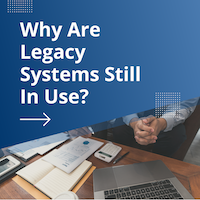A lot of industries still have legacy systems as part of their critical IT infrastructure, despite the many risks associated with them.
The membership sector is no different. In fact, the 2021 MemberWise Digital Excellence Report showed that legacy association management systems were one of the factors that were holding organisations back. It also claimed annual investment in technology exceeded the recommended 5%-10% of annual income. This is in part due to legacy systems.
It will be interesting to see how that number changes in the 2023 report.
Why Do Membership Organisations Still Use Legacy Systems?
There’s the good old saying “if it ain’t broke, don’t fix it” which is often applied to IT in the workplace. After all, if the system appears to be working as it should, why is there a need to replace it?
There are still legacy systems in use today for a number of reasons, including:
- Fits the brief it was initially built to do
- Custom-built to perform tasks that are unique to membership sector
- Perceived to be cheaper than replacing
- Perceived short-term reliability
- Internal reluctance to replace the system
Why Is This A Risk?
As previously mentioned, a membership organisation based on legacy technology is common practice. However, it is a cause for concern if left unsupported or in the hands of one or two developers. Not only does it become harder to find support, it can be left vulnerable to cyber attacks.
1. There’s a Legacy Skills Shortage
How many people within your organisation understand your legacy system? What would happen if your legacy developer handed their notice in tomorrow, or fell ill unexpectedly?
As a legacy system support provider, we’ve spoken to countless companies and organisations who lost their developer and needed support urgently. The main issue with legacy systems is hiring developers with knowledge of older code or how your custom-made system works.
By going with a support vendor (like us), you can be rest assured that whenever you need help, you can speak to the support team straight away and a developer will start fixing the problem straight away.
2. Security Not Updated
A legacy system would have been developed to combat the cyber threats of those times, leaving them exposed to the modern-day threats. Since your legacy system was built, attackers have become more sophisticated and new types of cyber threats have emerged; meaning your legacy system will have multiple “ways-in” for attackers to penetrate.
Through a managed support contract, your legacy system can be protected with the cyber defences of 2023 to reduce the likelihood of an attack.
3. Long-Term Costs Of Maintenance And Support
While the up-front cost of replacing your legacy with a new system can be daunting or simply unaffordable, the cost of repairing the legacy’s patches and fixing bugs over time can actually work out more in the long run once you’ve factored in in developer’s time, cost to repair and the impact on the business due to downtime.
4. Bad data
Does your organisation rely on the vast swathes of data that your legacy system collects? The worry here is that there are several risks associated with the data in your legacy system. There’s an extreme risk of data loss due to inadequate backups, potential non-compliance with data protection, and the data itself could be incomplete or inaccurate.
5. Cannot Integrate With Newer Technologies
Legacy systems are extremely hard to integrate well with newer technologies and infrastructure. In some cases, it’s practically impossible. This makes it a challenge to adopt cloud computing, mobile applications, or other innovative solutions that your members could benefit from. This can also limit your organisation’s ability to adapt to market trends and collaborate effectively.
The Solution?
The purpose of this isn’t to frighten anybody whose organisation relies on a legacy system. Not only am I highlighting the risks to ensure you’ve ticked them all off, it’s also to emphasise that replacing a legacy system isn’t the only solution.
Whether it’s performed internally by your technical teams, or outsourced to a legacy system support provider, by assessing your legacy system and its risks, you can develop a robust plan to enhance its features, tighten its security and spend less money on fixing bugs and repairing patches.
PSP IT Design & Development have worked with chartered institutes and education bodies for over a decade, supporting and upgrading their legacy membership platforms. We know that replacing a legacy system isn’t always a practical or affordable solution, which is why can takeover a legacy system, modernise it and give you more from your outdated system with little investment. Find out more here: https://www.psp-it.co.uk/legacy-system-support-and-modernisation/










Leave A Comment